
Incorporating your landscaping into your home’s design
By Maged Ahmed Published: 25/09/2024 | Updated: 25/09/2024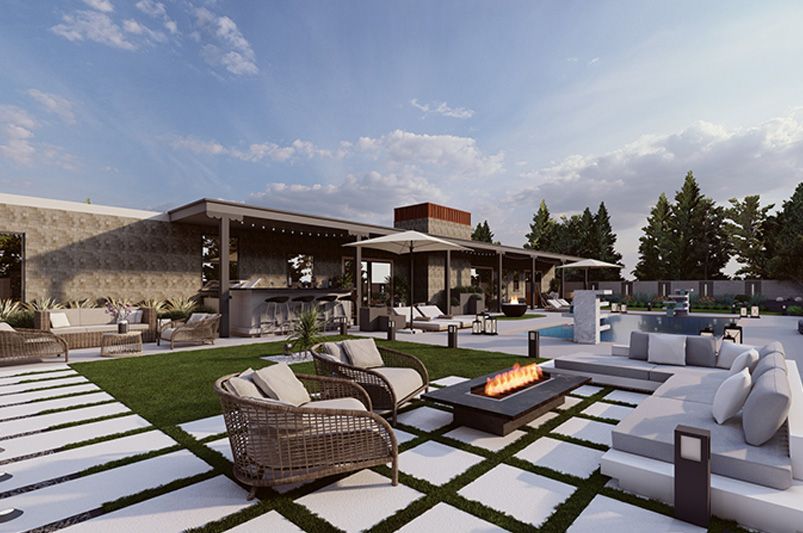
Incorporating your landscaping into your home’s design
Incorporating landscaping into your home’s design goes beyond aesthetics—it's about creating harmony between your living space and nature. Plants have a unique ability to enhance not only the beauty of your property but also your well-being. Whether you're working with a spacious garden or a cozy patio, the right greenery can breathe life into your surroundings, making your home feel vibrant and welcoming.


At ShrubHub, we believe in the transformative power of plants and the impact they can have on both your outdoor and indoor spaces. Our weekly blog is packed with expert advice, inspiring ideas, and tips to help you seamlessly integrate nature into your home's design. Dive in to discover how you can turn your landscape into a lush extension of your living space!
Ready to get started? Keep reading for practical tips on incorporating greenery into your home's design.
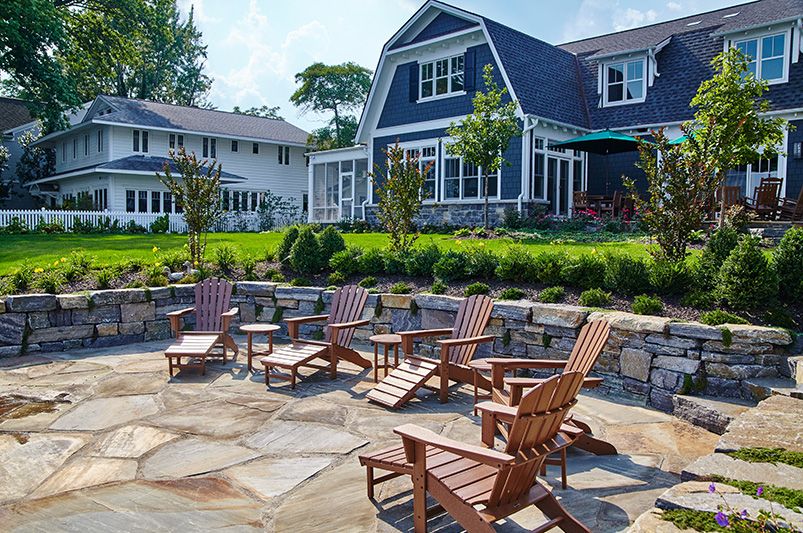
Choose Plants that Complement Your Home’s Architecture
The first step to seamlessly incorporating greenery into your home’s design is selecting plants that complement the architecture of your home. Whether you have a modern minimalist space or a traditional colonial style, the right plants can elevate your home’s aesthetic.
For contemporary homes, consider sleek, structured plants like ornamental grasses, boxwood, or bamboo. Their clean lines match well with modern design. If your home leans toward a more classic or traditional style, opt for lush, flowering plants like hydrangeas, azaleas, or roses to add charm and warmth.
Also, think about the scale of your plants in relation to your home. Taller trees like cypress or magnolia can frame your house beautifully, while smaller shrubs like lavender or sage create balance and soften the hard edges of pathways or patios.
At ShrubHub, we offer a wide variety of plant options tailored to every home style. Check out our plant selection to find the perfect match for your space!
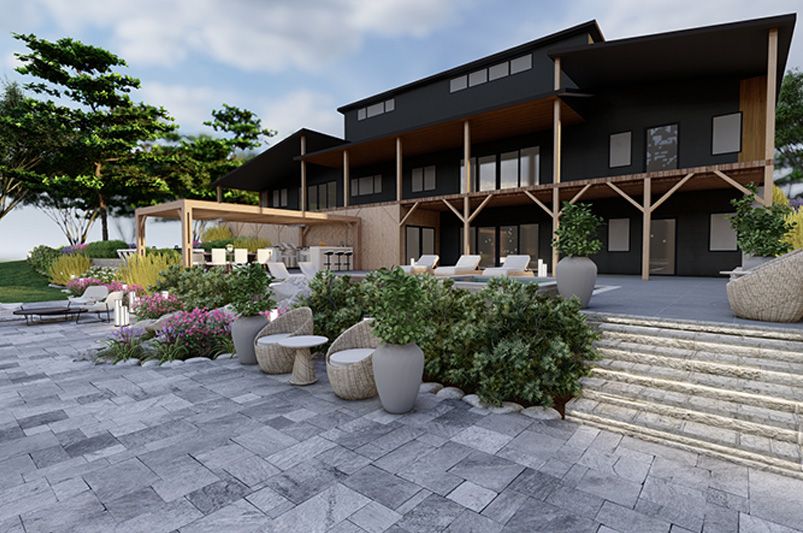
Framing Your Home with Trees and Shrubs
Trees and shrubs are the foundation of a well-designed landscape, providing structure, depth, and balance to your home’s exterior. The way you place these elements around your property can transform not only how your home looks but how it feels. When done thoughtfully, greenery can highlight architectural features, create a sense of grandeur, or add a natural softness to harsh lines.
Highlight Key Architectural Features with Trees
Trees can act as natural frames for your home, drawing attention to specific architectural features or enhancing the overall design. For example, placing tall, elegant trees like maples or oaks on either side of your home’s entrance can create a welcoming effect, leading the eye toward the front door. If your home has large windows or a distinctive roofline, you can use medium-sized trees like magnolias or dogwoods to emphasize these elements without overshadowing them.
Trees also serve practical purposes. Deciduous trees planted near windows provide shade in the summer and allow sunlight through during winter months, naturally cooling or warming your home. Trees like birch or cherry blossom, known for their stunning seasonal changes, add both visual interest and functional benefits.
Use Shrubs to Create Layers and Boundaries
Shrubs, on the other hand, are ideal for building layers within your landscape and creating a seamless transition between larger trees and smaller garden elements. Low-growing shrubs like boxwoods or lavender can be placed along walkways or around the foundation to define areas without blocking sightlines. Taller shrubs, such as holly or rhododendrons, can provide privacy, create natural boundaries, or conceal less appealing aspects of your property like utility boxes.
Strategically placed shrubs also soften the transition between hard surfaces—such as driveways, patios, or walkways—and the lush greenery of your garden. A row of shrubs along a driveway, for instance, can provide a visual buffer while adding texture and depth to the space.
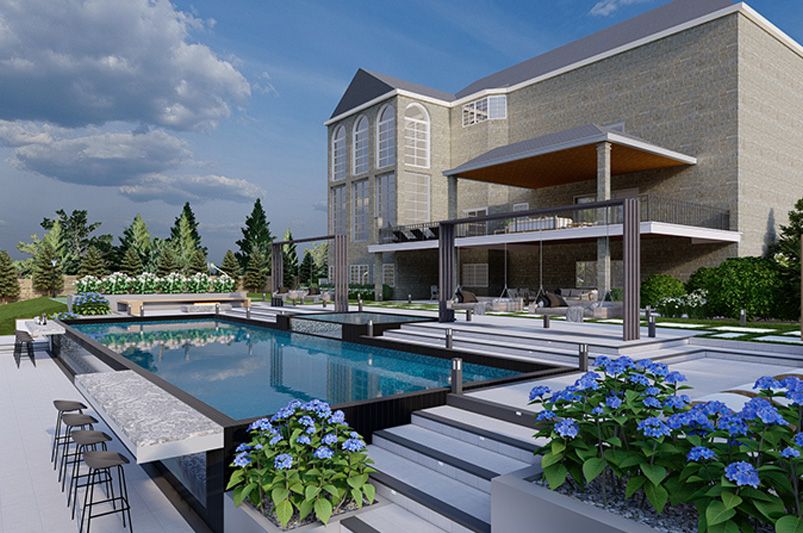
Creating Natural Focal Points with Greenery
Beyond framing your home, trees and shrubs can be used to create natural focal points in your landscape. A well-placed flowering tree or a sculpted evergreen can serve as a striking centerpiece, drawing attention and adding dimension to an otherwise flat or empty area. For example, a blooming cherry tree in the front yard or a vibrant red maple at the corner of your garden can be showstopping features that bring balance and interest to your landscape design.
Ultimately, the key to framing your home with greenery is ensuring that the scale, shape, and color of the plants you choose harmonize with your home’s architecture and the surrounding landscape. Whether you’re aiming for a stately, traditional look or a more relaxed, natural feel, trees and shrubs provide the framework to make your home’s design come alive.
Need help selecting the perfect trees and shrubs for your property? Explore ShrubHub’s extensive plant catalog, where we offer customized solutions to fit your design needs and climate conditions.
Enhancing Outdoor Spaces with Garden Beds and Planters
Incorporating garden beds and planters into your landscape design adds a versatile and creative element to your home’s exterior. They allow for flexible planting arrangements and provide a structured way to introduce a variety of greenery into your outdoor spaces, creating a balanced look that complements your home’s architecture.
Defining Spaces with Garden Beds
Garden beds are an excellent way to define specific areas around your home, adding both functionality and beauty. Whether you’re lining your driveway, outlining your front walkway, or framing your backyard patio, garden beds can transform bare areas into lush, vibrant spaces.
The plants you choose for these beds will depend on the style of your home and the overall effect you’re aiming for. For example, if you prefer a minimalist, modern aesthetic, consider filling your garden beds with ornamental grasses or low-maintenance succulents. For a more classic or cottage-style look, use perennial flowers like daylilies or hydrangeas, which offer a pop of color while requiring little upkeep.
Raised garden beds are another option for homeowners who want to bring height and depth to their landscape. They work particularly well in small yards or areas where the soil quality may not support a wide variety of plants. Raised beds can also be arranged in geometric patterns, adding a design-forward element to your garden.
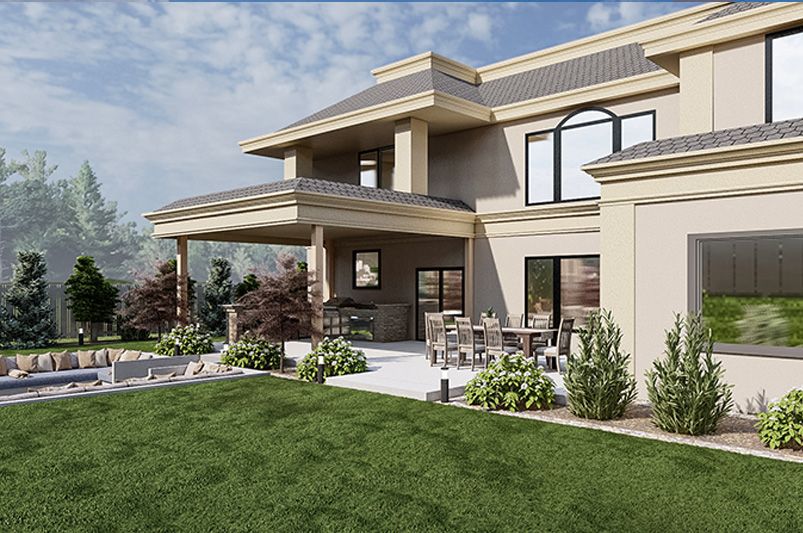
Strategic Placement of Planters
Planters are another versatile option for incorporating greenery into your landscape. They’re ideal for areas where you want to add plants but don’t have the space or conditions for a full garden bed. Planters can be placed around patios, entrances, or even along windowsills to create pockets of greenery that seamlessly blend with your home’s architecture.
Choose planters that complement your home’s exterior. For example, sleek, metallic planters may pair well with modern homes, while terracotta or wooden planters could enhance a more rustic or traditional design. Grouping planters of different sizes together can create visual interest, and using a mix of greenery, flowering plants, and cascading vines will give your space depth and texture.
Filling Planters with Seasonal Plants for Year-Round Interest
One of the great benefits of using planters is their flexibility. You can switch out the plants seasonally, ensuring that your landscape remains vibrant and engaging all year round. In the fall, you might fill your planters with ornamental cabbages, pansies, or chrysanthemums to create a warm, autumnal feel. In spring and summer, vibrant annuals like petunias or geraniums can bring bright colors to your outdoor areas.
Another advantage of planters is their mobility. If a particular area of your yard doesn’t get enough sunlight or if you want to rearrange your layout, you can easily move planters to different spots until you find the perfect fit.
Complementing Your Garden Design with Containers
To fully integrate your planters and garden beds into your landscape, consider how they interact with the surrounding space. Use them to soften the edges of hard surfaces, such as walkways or patios, by placing planters with trailing plants like ivy or creeping thyme at the borders. Additionally, consider adding height by using tall planters with upright plants or small trees, creating visual layers that draw the eye upward.
At ShrubHub, we offer a wide selection of planters and garden bed ideas, along with expert guidance on plant selection and layout. Whether you’re looking to enhance your home’s curb appeal or create a cozy backyard retreat, we’ve got the tools and inspiration to bring your vision to life. Check out our weekly blog for more tips on designing with plants!
Conclusion
Incorporating greenery into your home's design is more than just a visual upgrade—it's a way to create harmony between your living spaces and the natural world. From the strategic placement of garden beds and planters to choosing the perfect plants that reflect your style, the right landscape design can elevate your home’s aesthetic while enhancing its functionality. With thoughtful planning, you can ensure your landscape thrives all year round, creating an outdoor space that you’ll love.
Ready to transform your yard? At ShrubHub, we’re here to help you design a landscape that blends seamlessly with your home. Whether you need expert advice on plant selection, garden bed design, or planter options, we’ve got you covered. Explore our wide range of plants, check out our inspirational blog articles, and get started on your landscape makeover today! Don't wait—visit ShrubHub.com for your free consultation!


